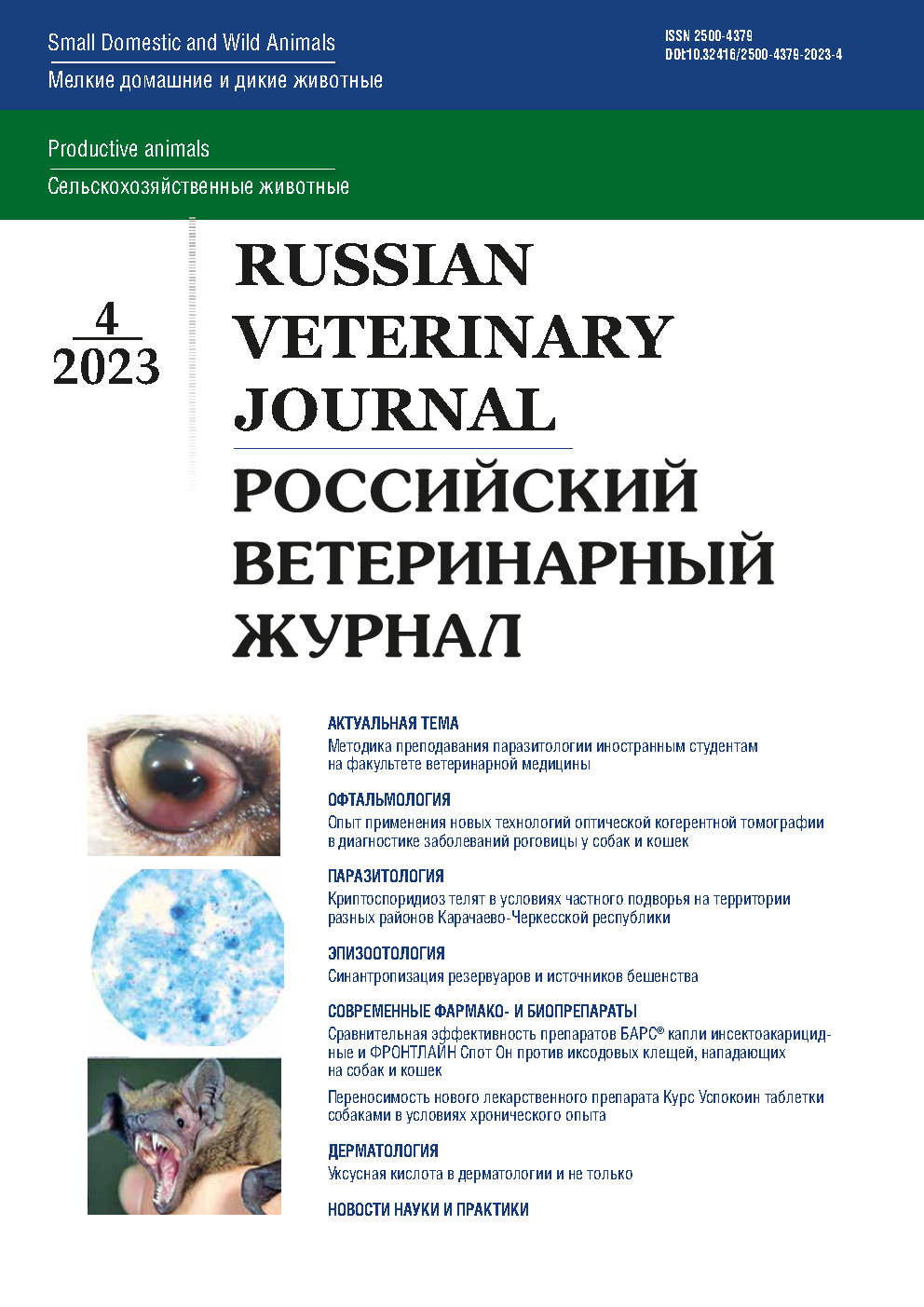FGBU «Veterinary Center»
Moskva, Moscow, Russian Federation
CSCSTI 68.41
The lecture material is devoted to the little-discussed phenomenon of synanthropization of problem animals as a powerful potential vector for the emergence of infectious diseases of natural focal origin due to changes in ecological interactions in the systems “wild animals ↔ domestic animals ↔ humans.” In particular, real facts and mechanisms of integration into anthropourgical conditions of animals real reservoirs and sources of rabies are considered.
synanthropization, anthropurgic conditions, rabies, foxes, raccoon dogs, bats, stray dogs, wolves, synergizing factors
1. Beznadzornye zhivotnye v Moskve. Internet-resurs. Rezhim dostupa: https://ru.wikipedia.org/
2. Kucheruk, V.V. Izbrannye trudy / V.V. Kucheruk. - M.: T-vo nauchn. izd. KMK, 2006. - 524 s.
3. Makarov, V.V. Emerdzhetnye bolezni, biologicheskie invazii, kaban-vreditel' / V.V. Makarov // Pest-menedzhment. - 2021. - № 2. - S. 8-16.
4. Makarov, V.V. Obschaya harakteristika sovremennoy epizootologii beshenstva. Statisticheskiy analiz obstanovki / V.V. Makarov, S.I. Dzhupina, V.A. Vedernikov i dr. // Veterinarnaya patologiya. - 2002. - № 1. - S. 59-64.
5. Makarov V.V., Veterinarnaya biologiya rukokrylyh / V.V. Makarov, D.A. Lozovoy // Vestnik ohotovedeniya. -2016. - T. 13. - № 1. - S. 43-57.
6. Makarov, V.V. Epizootologicheskaya metodologiya v diagnostike, terapii i profilaktike infekcionnyh, parazitarnyh i nezaraznyh bolezney zhivotnyh. Chast' 1 V.V. Makarov, O.I. Suharev, S.I. Dzhupina // Veterinarnaya patologiya. - 2009. - № 1 (28). - S.103-111. Chast' 2. Tam zhe. - 2009. - № 2 (29). - S. 112-119.
7. Meshkova, N.N. Orientirovochno-issledovatel'skaya deyatel'nost', podrazhanie i igra kak psihologicheskie mehanizmy adaptacii vysshih pozvonochnyh k urbanizirovannoy srede / N.N. Meshkova, E.Yu. Fedorovich. - M.: Argus, 1996. - 226 s.
8. Sergiev, V.P. Infekcionnye bolezni i civilizaciya / V.P. Sergiev, N.A. Malyshev, I.D. Drygin. - M., 2000. - 207 s.
9. Sergiev, V.P. Infekcionnye bolezni na rubezhe vekov: osoznanie biologicheskoy ugrozy/ V.P. Sergiev, N.N. Filatov. - M.: Nauka, 2006, 572 s.
10. Sinantropizaciya problemnyh dikih zhivotnyh: veterinarno-epidemiologicheskoe znachenie fenomena. Otchet o NIR (V.V. Makarov i dr.). - M.: RUDN, 2013.
11. Skol'ko bezdomnyh sobak naschityvaetsya v regionah Rossii. Internet-resurs. Rezhim dostupa: https://vetandlife.ru/
12. Centr pravovoy zaschity. Internet-resurs. Rezhim dostupa: http://www.animalsprotectiontribune.ru/
13. Yaremenko, D.M. Nekotorye aspekty biologii lisicy i enotovidnoy sobaki / D.M. Yaremenko // Veterinarnaya patologiya. - 2002. - № 1. - S. 111-118.
14. A pandemic era. Internet-resurs. Rezhim dostupa: https://www.thelancet.com/journals/lanplh/article/PIIS2542-5196(20)30305-3/fulltext
15. Blancou, J. Transmission du virus de la rage: importance de la barrière d'espèce Transmission of rabies virus: importance of the species barrier] / Blancou J., Aubert M. // Bull Acad Natl Med. - 1997 Feb. - No. 181(2). - pp. 301-11.
16. Deplazes, P. Wilderness in the city: the urbanization of Echinococcus multilocularis. / P. Deplazes, D. Hegglin, S. Gloor et al. // Trends in Parasitol. - 2004. - Vol. 20, - No.2. - pp. 77-84.
17. Harris S., Baker P. Urban foxes / S. Harris, P. Baker. - Whittet Books, Suffolk. 2001. - 136 p.
18. Geda, M. Ecological and Economic Importance of Bats (Order Chiroptera) / M. Geda, M. Balakrishnan // Biodiversity. - 2013. No. 1. - pp. 1-9. DOIhttps://doi.org/10.1155/2013/187415
19. Klestova Z. Possible spread of SARS-CoV-2 in domestic and wild animals and body temperature role. Virus Res. 2023 Apr 2;327:199066. doi:https://doi.org/10.1016/j.virusres.2023.199066.
20. Lewanzik, D. Evaluating the potential of urban areas for bat conservation with citizen science data / D. Lewanzik, T. Straka, J. Lorenz et al. // Environmental Pollution. - 2022. - No. 297. - pp. 118785. https://doi.org/10.1016/j.envpol.2021.118785
21. MacDonald D. The behavioural ecology of the fox / D. MacDonald. - In: Rabies. The facts. Ed. C. Kaplan. Oxford UP. 1977. - pp. 70-90.
22. Mackenstedt, U. The role of wildlife in the transmission of parasitic zoonoses in peri-urban and urban areas / U. Mackenstedt, D. Jenkins, T. Romig // Int J Parasitol Parasites Wildl. - 2015 Feb. - Vol. 7. - No. 4(1). - pp. 71-9. doi:https://doi.org/10.1016/j.ijppaw.2015.01.006.
23. Mendoza, R. Zoonotic parasites associated with predation by dogs and cats / R. Mendoza, D. Otranto // Parasites Vectors. - 2023. Available at: https://doi.org/10.1186/s13071-023-05670-y
24. Soulsbury, C. The impact of sarcoptic mange Sarcoptes scabiei on the British fox Vulpes vulpes population / C. Soulsbury, G. Iossa, Baker Ph. et al. // Mammalian review. - 2007. - No. 37(4). - pp. 278-296. DOIhttps://doi.org/10.1111/j.1365-2907.2007.00101.x
25. The city fox phenomenon. Available at: https://ecologyandevolutionblog.wordpress.com/2019/02/18/the-city-fox-phenomenon/
26. Tomori, O. Domestic Animals as Potential Reservoirs of Zoonotic Viral Diseases / O. Tomori, D. Oluwayelu // Annual Review of Animal Biosciences. - 2023. - Vol. 11. - No. 1. - pp. 33-55.
27. Wandeler, P. The city-fox phenomenon: genetic consequences of a recent colonization of urban habitat / P. Wandeler, S. Funk, C. Largiadèr et al. // Molecular Ecology. - 2003. - No. 12. - pp. 647-656.
28. WHO/WSAVA. Guidelines to reduce Human Health Risks associated with Animals in Urban Areas. Geneva, VPH/81.29., 1981. - 74 p.








